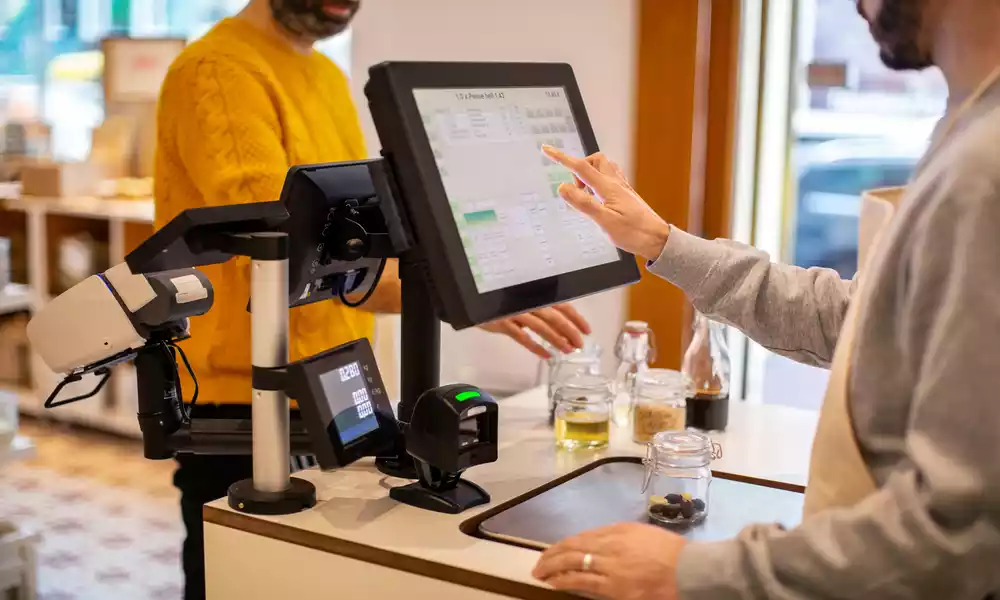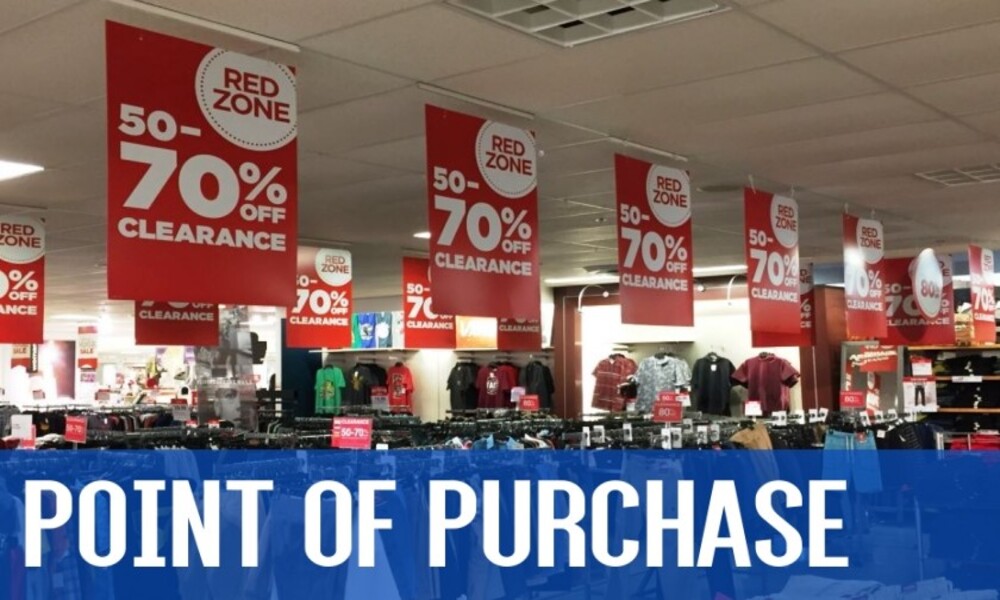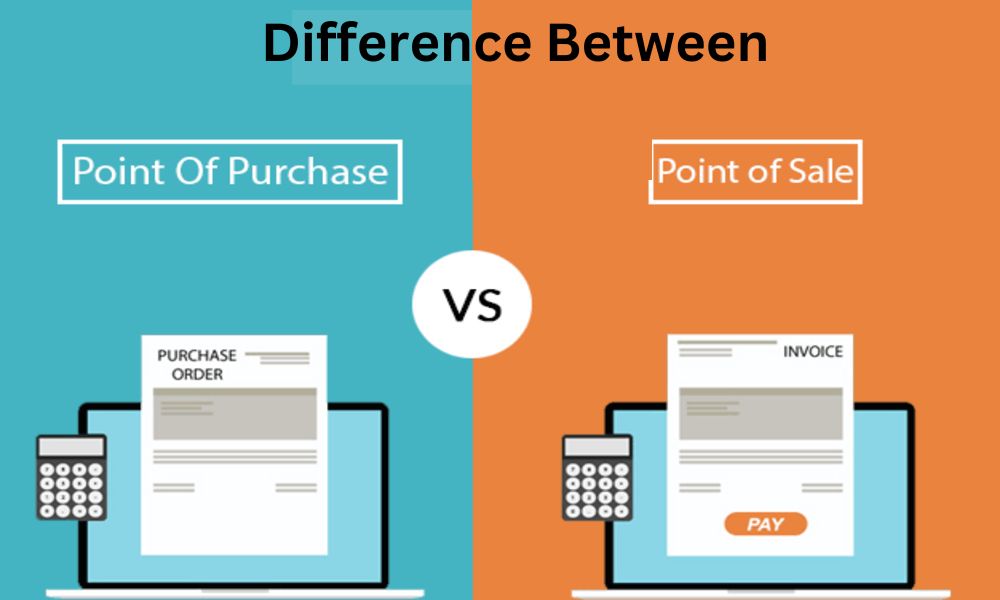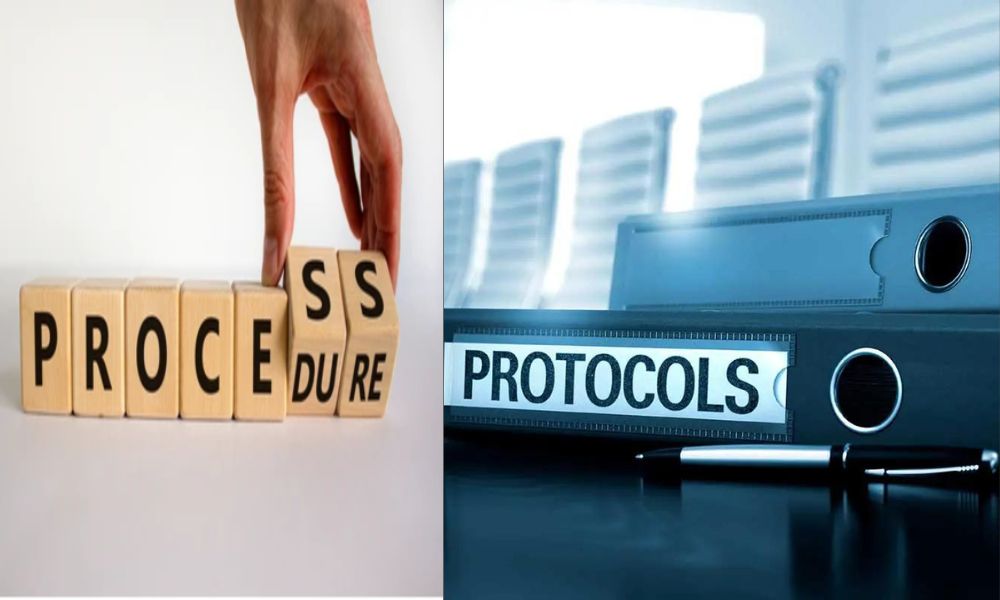Introduction of Point of Sale and Point of Purchase
Understanding the differences between point of sale (POS) and point of purchase (POP) in retailing and marketing is paramount to staying abreast of modern customer journeys. Both terms may sound similar but each encompasses distinct concepts and plays different roles along customer paths.
A point of sale refers to any location – whether physical or virtual – where transactions between merchants and customers take place, from payment processes to finalizing purchases. Furthermore, this location often serves as an effective platform for placing marketing materials designed to influence consumer behavior and prompt purchasing decisions.
By understanding the differences between POS and POP, businesses can create targeted strategies to optimize customer interactions, boost sales, and offer an unforgettable shopping experience.
In this content outline, we will explore definitions, components, differences, significance, roles in the buying process, and the impact of both. Furthermore, real-life examples and case studies will be explored that illustrate the successful implementation of both strategies.
What is Point of Sale (POS)?
Point of Sale (POS) refers to any physical or virtual location where sales transactions take place between merchants and customers. Often this step includes payment for goods or services rendered.
Point-of-sale systems comprise various hardware (cash registers, barcode scanners, and card readers) and software components that facilitate and record transactions at the point of sale (POS). A physical store typically designates one checkout counter or area as the POS. Online, the point-of-sale (POS) system may take the form of either a virtual shopping cart or a secure payment gateway on a website.
Its primary function is to accurately calculate total purchase amount, process payments and generate receipts while modern POS systems often offer features like inventory management, sales analytics, and customer relationship management tools to facilitate efficient operations while improving overall customer experiences.

What is the Point of Purchase (POP)?
Point of Purchase (POP) refers to any location at which a consumer makes purchasing decisions or is persuaded to acquire products or services. Contrast with point of sale (POS), which refers specifically to transactional activities, point of purchase refers more generally to marketing and promotional efforts that take place prior to sales transactions.
Marketing includes various elements strategically placed throughout a store or online platform to draw in customers, provide product information, and encourage impulse purchases. POP marketing materials typically include displays, signage, product demonstrations, product samples, shelf talkers and in-store promotions.
POP’s purpose is to influence consumer behavior, drive sales and enhance the shopping experience; often by creating visually appealing displays with persuasive messaging to attract customer interest and encourage purchases.

Difference Between Point of Sale and Point of Purchase
Sure! Here’s a comparison table highlighting the key differences between Point of Sale (POS) and Point of Purchase (POP):
| Point of Sale (POS) | Point of Purchase (POP) |
|---|---|
| The transactional moment where the customer pays for goods or services | Pre-purchase stage focused on marketing and influencing buying decisions |
| The location where the transaction takes place, either physical or virtual | The location where marketing materials are strategically placed to attract customers |
| Involves the final step of the purchase process | Occurs before the actual purchase decision is made |
| The primary goal is to process payments and generate receipts | The primary goal is to influence consumer behavior and prompt purchasing decisions |
| Typically involves hardware and software components, such as cash registers and POS systems | Utilizes various marketing materials, such as displays, signage, and product demonstrations |
| Records and manages sales transactions, inventory, and customer data | Enhances the overall shopping experience and drives sales through visual appeal and persuasive messaging |
| Supports operational functions, such as inventory management and sales analytics | Enhances brand visibility and creates a positive brand impression |
| Examples include checkout counters in physical stores and virtual payment gateways online | Examples include product displays, shelf talkers, and in-store promotions |
| Focuses on the transaction and payment process | Focuses on marketing strategies and tactics to capture customer attention and influence purchase decisions |
| An integral part of the customer journey but occurs towards the end | Plays a crucial role in attracting and engaging customers before they reach the transactional stage |
Understanding these distinctions can help businesses develop comprehensive strategies that leverage both the POS and POP to drive sales, create memorable customer experiences, and maximize overall business success.
The Role of POP Displays in a Sales Strategy
Point of Purchase (POP) displays are integral parts of any sales strategy, helping capture customer attention, influence purchasing decisions, and drive sales. POP displays are specially-crafted marketing materials strategically placed within stores or online platforms in order to promote certain products or brands.
Here are some key aspects highlighting POP displays’ significance as part of sales strategies:
Attracting Customer Attention: POP displays are created to draw customers in. By employing eye-catching colors, creative designs, and compelling messaging techniques, they can quickly grab people’s attention and draw them towards promoted products.
POP displays provide an effective means of increasing brand visibility among customers by prominently showcasing logos, images, and key messaging of a brand’s logo, imagery, and messaging – increasing recognition and presence in their minds – potentially leading to future purchases by these same customers.
Enhancing Product Knowledge: POP displays provide customers with valuable information regarding product features, benefits, and usage. They allow companies to showcase product samples or provide demonstrations while displaying informational signage; ultimately enabling customers to make more informed purchase decisions.
Create a Sense of Urgency: Time-limited promotions, exclusive offers, or limited edition products displayed through POP materials can create urgency among customers by emphasizing scarcity or time restrictions – thus encouraging immediate purchases and impulse buys.
Influencing Impulse Purchases: Well-placed and visually appealing POP displays can stimulate impulse purchases by strategically positioning complementary products or emphasizing special offers. They may tempt customers to add extra items or make unplanned purchases.
Cross-Selling and Up-Selling Opportunities: POP displays can provide cross-selling and up-selling opportunities by highlighting similar or upgraded products, providing cross-selling/up-selling opportunities. By showing complementary items or suggesting premium versions, POP displays can increase transaction values and drive sales growth.
Enhancing the In-Store Experience: Engaging and well-designed POP displays contribute to an enjoyable shopping experience by adding visual interest, breaking up store layout monotony, and providing customers with an interactive environment for shopping.
Differentiating from Competitors: Creative and innovative POP displays can set a brand apart from its competition, by emphasizing its distinctive brand identity and employing new display techniques to provide customers with an unforgettable shopping experience.
Integrating POP displays into sales strategies can have a tremendous effect on customer engagement, product visibility, and sales volume. By designing and placing POP displays strategically businesses can effectively influence consumer behavior, drive purchases and ultimately increase revenues.
The Role of POS Displays in a Sales Strategy
Point of Sale (POS) displays aren’t commonly associated with sales strategies; their main function is the transactional completion of purchases. However, the term can also refer to promotional material or product showcases located at a point of sale.
Given this interpretation, let’s examine how POS displays could fit into sales strategies:
Upselling and Cross-Selling: Point-of-sale displays placed near checkout counters or sales floors can be used to promote additional products that complement customer purchases, increasing average transaction values by inducing additional item purchases. This strategy may encourage customers to add on other purchases as part of their transaction, increasing average transaction values overall.
Last-Minute Impulse Purchases: POS displays can entice customers during the final stages of their shopping journey by featuring small, affordable products with limited-time offers that pique consumers’ interest and encourage impulse buys. By doing this, businesses can capitalize on impulse sales revenue growth by prompting customers to add extra items to their purchases, ultimately increasing revenue growth.
Brand Reinforcement: POS displays can be an effective tool to strengthen brand identity and increase recognition among customers. By including consistent branding elements like logos, slogans, and imagery in displays, businesses can reinforce their brand in customers’ minds, increasing loyalty and affinity towards it.
Highlight Promotions and Discounts: Point-of-sale displays can effectively communicate ongoing promotions, discounts, or loyalty program benefits to customers at the point of sale. Placing these displays strategically near the point of sale can catch customers’ eye and encourage them to take advantage of promotional offers leading to increased sales.
Informative and Educational Materials: Point-of-sale displays provide an ideal platform to disseminate relevant product information, usage tips, or educational materials that help customers make more informed purchasing decisions while creating a positive buying experience, leading to customer loyalty and potential repeat business.
Queue or Waiting Area Management: In cases where customers must wait in line to complete their purchase, POS displays can help alleviate perceived wait time by offering entertaining or informative content, product features, or special offers that keep customers engaged while potentially leading to additional purchases.
Due to their similar-sounding names, “POS displays” may often be confused with “POP displays.” POP displays focus on pre-purchase marketing and informing decisions; while POS displays aim to improve transactional experiences and capture last-minute sales opportunities.
Attributes of Modern POS Systems
Modern Point of Sale (POS) systems offer a variety of features and capabilities designed to increase efficiency, streamline operations, and enhance customer experiences.
Here are some key characteristics of modern POS systems:
Cloud-Based Technology: Modern POS systems often utilize cloud technology, providing businesses with easy access to their data from any location and real-time synchronization across multiple devices. Cloud systems also provide scalability, data security, and automatic software updates – features many businesses require for smooth operations. Modern POS systems are built to integrate seamlessly with various sales channels, such as physical stores, e-commerce platforms, mobile apps, and marketplaces. This enables businesses to consolidate sales data across different channels for inventory control purposes.
Omnichannel Capabilities: Modern POS systems support omnichannel retailing, providing customers with an excellent shopping experience across different channels. These systems enable click-and-collect capabilities, buy online/return in-store capabilities, and inventory visibility across channels.
Mobility and Flexibility: With the proliferation of mobile devices, modern POS systems now typically provide mobile or tablet options for taking payments and managing sales on the go – whether that means in-store or pop-up locations such as events. This provides businesses with greater convenience. Modern POS systems support multiple payment options beyond cash and card, such as mobile wallets, contactless payments, online payment gateways, and cryptocurrency transactions.
Inventory Management: Modern POS systems feature advanced inventory management features. These systems can track stock levels, provide real-time visibility into stock availability, automate reordering processes, generate performance reports on product performance, and prevent stockouts allowing businesses to optimize inventory management and prevent stockouts.
Customer Relationship Management (CRM): Many modern POS systems include CRM capabilities that enable businesses to capture customer data, track purchase history and tailor the shopping experience accordingly. Features of CRM may include loyalty programs, customer segmentation strategies, targeted marketing campaigns, and personalized offers.
Analytics and Reporting: Modern POS systems feature powerful analytics and reporting features, giving businesses unparalleled insights into sales performance, inventory turnover, customer behavior, and other essential metrics. This data-driven approach empowers businesses to make informed decisions, optimize operations and identify growth opportunities more quickly than ever.
Integration With Third-Party Apps: Modern POS systems typically offer integrations with various third-party applications and services, including accounting software, marketing tools, e-commerce platforms, and customer review systems. This integration streamlines workflows and boosts operational efficiency.
User-Friendly Interface: Modern POS systems prioritize user experience. Their user-friendly interfaces offer staff quick learning curves and navigation of the system; in turn, this can contribute to smoother transactions and enhanced customer service. Modern POS systems enable businesses to streamline operations, gain actionable insights and provide their customers with a superior shopping experience.
Attributes of Modern POP Systems
POP (Point-of-Purchase) systems typically refer to the strategic placement of marketing materials rather than specific software or technologies, yet there are certain characteristics associated with modern POP systems that distinguish them.
Here are some attributes and characteristics associated with modern POP systems:
Eye-Catcher Displays: Modern POP systems focus on designing eye-catching displays to capture customer interest, including using vibrant colors, innovative designs, and distinctive visuals that stand out in retail environments.
Customizability and Flexibility: Modern POP systems allow businesses to tailor them specifically to their own specific needs and branding, providing complete flexibility with regards to size, shape, and arrangement of displays allowing for creative display setups that draw customers in.
Integration of Digital Elements: Modern POP systems increasingly incorporate digital elements, including digital signage, interactive displays, or video screens, that offer dynamic content such as product demos or engaging experiences to engage customers and create memorable interactions. These components provide engaging demos for product demos or interactive experiences to deliver engaging customer interactions and experiences that leave lasting memories behind.
Interactive and Engaging Features: Modern POP systems strive to offer customers an engaging experience through interactive features, such as touch screens, product samples they can try for free, interactive games or quizzes, virtual or augmented reality experiences (AR/VR) experiences, or other immersive elements.
Data-Driven Insights: Many modern POP systems incorporate technologies that collect customer interaction data and offer insight into customer engagement with displays. This can involve monitoring customer interactions, analyzing behavior data on customers and preferences, and producing reports to inform future marketing strategies.
Integration With Digital Marketing Channels: Contemporary POP systems often include integration with digital marketing channels such as social media or mobile apps to provide a coherent brand experience across various touchpoints. This integration may involve promoting POP displays through digital channels or using customer data collected during digital interactions to inform POP strategies.
Environmental Sustainability: With environmental sustainability becoming ever-more significant, modern POP systems may prioritize eco-friendly materials and practices such as recycling or biodegradable display materials; reducing waste; and adopting eco-friendly manufacturing and disposal processes.
Collaboration With Brand Partners: Modern POP systems may facilitate collaboration among brands, retailers, and other brand partners through co-branded displays, joint marketing efforts, or cross-promotion of products in order to increase visibility and impact.
Measurable ROI: Modern POP systems may include mechanisms to accurately assess return on investment (ROI). This could involve tracking sales or customer interactions linked to specific displays, conducting customer satisfaction surveys or feedback collections, or using digital analytics to assess the impact of POP strategies.
Integration with POS Systems: While not an integral feature of POP systems themselves, integration with Point-of-Sale (POS) systems can enhance their effectiveness by creating seamless coordination between marketing initiatives and transactional aspects of customer journeys. Modern POP systems enable businesses to design engaging displays that effectively influence customer behavior, promote products, and enhance shopping experiences. Leveraging technology, customization options, and data-driven insights – modern POP systems play a pivotal role in driving sales and building brand recognition.
Successful implementations of POS strategies
Successful implementations of Point-of-Sale (POS) strategies are evident across a wide variety of industries.
Here are just a few businesses that have utilized these tactics successfully to increase sales and enhance the customer experience:
Apple Inc.: Apple stores are well known for their innovative POS strategies. Sales associates use mobile POS devices such as iPads to assist customers throughout their shopping experience and process transactions immediately, as well as provide personalized recommendations – making for an efficient checkout process and enriching overall shopping experiences.
Starbucks: Starbucks achieved success in its point-of-sale (POS) strategy through its mobile ordering and payment system, enabling customers to make orders and payments directly via the Starbucks mobile app, bypassing lines to collect them directly at the counter. Not only has this increased customer convenience but also improved order accuracy while streamlining operations during peak times.
IKEA: IKEA has recently implemented self-checkout kiosks in their stores, allowing customers to scan and pay for items independently without waiting in line at traditional checkout counters. This reduces wait time significantly while providing customers with a faster and more efficient shopping experience. Furthermore, their POS strategy also incorporates barcode scanning technology so customers can check product availability, pricing information, or additional product features quickly.
Whole Foods Market: Whole Foods implemented an effective POS strategy by taking advantage of customer loyalty programs. By providing discounts and special offers exclusively to their loyalty cardholders – integrated seamlessly into the POS system – Whole Foods effectively encourages repeat purchases while building customer relationships that provide valuable data for targeted marketing initiatives.
Nordstrom: Nordstrom recently implemented a “mobile checkout” feature in their stores, enabling sales associates to process transactions using mobile devices instead of long checkout lines. Customers are able to purchase from anywhere within the store while sales associates provide personalized service and recommendations during transactions using this strategy.
McDonald’s: To improve order accuracy and reduce wait times for their customers, McDonald’s introduced self-service kiosks at many of their locations, enabling customers to place and customize orders themselves using user-friendly touchscreens. This POS strategy improved order accuracy while simultaneously creating a more convenient and customized ordering experience.
Successful implementations of point of sale (POS) strategies demonstrate how businesses can utilize technology, convenience and personalized experiences to enhance the customer journey, streamline operations and drive sales.
By optimizing checkout processes, integrating loyalty programs, and using mobile devices these businesses have implemented their POS strategies effectively to meet customer expectations and achieve business success.
Effective utilization of POP marketing techniques
Implementation of Point-of-Purchase (POP) marketing techniques can make an enormous difference in customer engagement, purchasing decisions, and sales growth.
Here are a few businesses that have implemented POP marketing techniques effectively:
Coca-Cola: Coca-Cola has long been recognized for its eye-catching point-of-purchase displays, from floor stands and countertop displays to interactive signage in stores to promote its products. They utilize various POP techniques – floor stands, countertop displays, and interactive signage – in their promotions in-store, often employing seasonal themes and engaging visuals that draw customer interest and drive impulse purchases.
Nike: Nike uses POP marketing techniques effectively in stores to highlight their footwear and apparel products, using visually appealing displays with eye-catching products to draw customers’ attention and innovative materials and lighting effects to draw in passersby. They collaborate with athletes and influencers to provide engaging experiences around their offerings while simultaneously creating buzz around them.
Sephora: Sephora is a beauty retailer known for strategically placing POP displays near checkout counters to encourage last-minute purchases and drive impulse buys. They display mini-sized products, travel kits, and impulse-buy items to attract customers. Furthermore, Sephora uses interactive displays and product testers to engage their customers and encourage them to try out new products.
LEGO employs POP marketing techniques to create attractive in-store displays that showcase their building sets and promote product exploration. Their displays often feature large-scale LEGO models or interactive play areas designed to engage children as well as their parents, making the shopping experience memorable and pleasurable.
Nestle: To promote its food and beverage products in grocery stores, Nestle employs POP marketing techniques such as endcap displays, shelf talkers, and aisle displays featuring them Furthermore, the brand employs strategic positioning techniques and creative packaging techniques in order to outshone competitors.
Red Bull: Red Bull has become well-known for their innovative and effective point-of-purchase (POP) marketing techniques. Utilizing custom-designed refrigerators, coolers, displays, and promotional activities such as sponsoring events or creating themed displays they have established an eye-catching presence across retail locations to reinforce brand recognition among their target market and reinforce the Red Bull identity.
Sony: To increase customer trust in its electronics products, Sony uses digital POP displays in its electronics sections to demonstrate their features and capabilities. Through interactive screens and demo units, customers are allowed to experience the technology firsthand – this helps inform purchase decisions while instilling greater confidence in them.
These examples demonstrate how effective use of POP marketing techniques can create visually appealing displays, engage customers, and generate excitement around products.
By strategically placing displays, including interactive elements, and aligning branding/promotional strategies with POP marketing efforts, these businesses have successfully employed this form of promotion to enhance customers’ overall shopping experiences and drive sales.
How companies leverage both POS and POP for maximum impact
Companies can utilize both Point-of-Sale (POS) and Point-of-Purchase (POP) strategies together to maximize sales impact and customer engagement.
Here are some strategies businesses can integrate both POS and POP techniques:
Maintain Consistent Branding Elements: Ensure a cohesive and recognizable brand presence across both point-of-sale (POS) and point-of-purchase (POP) materials with consistent colors, logos, fonts, and messaging to reinforce brand identity and boost recall. This will lead to enhanced customer experiences.
Strategic Placement: Placing POP displays at key touchpoints within your store – such as entrance areas, high-traffic aisles, and near checkout desks – is key to drawing customer attention and encouraging impulse purchases. Align their placement with that of POS systems for an uninterrupted transition from browsing to checkout.
Product Information and Upselling: Integrate product information and upselling messages into both POS and POP materials, using shelf talkers or product signage to emphasize key features, benefits, or limited-time offers. Train sales associates to reinforce these messages during customer interactions at the POS register while emphasizing opportunities to upsell based on what customers buy.
Cross-Promotion: Take advantage of both POS and POP to cross-promote complementary products or related items, by strategically placing POP displays near relevant product sections or using digital signage at the POS to suggest add-on purchases. This encourages customers to consider additional purchases while increasing average transaction values.
Loyalty Programs: Integrate loyalty program promotions and benefits into both POS and POP strategies, such as endcaps or countertop displays, to make customers join. Furthermore, sales associates should actively promote the program during each POS transaction; this encourages customer membership while opening up opportunities for targeted marketing based on purchasing history.
Interactive Experiences: Integrating technology and interactive elements into both POP displays and POS transactions to engage customers is essential in providing a smooth customer journey. Use digital screens or kiosks at POP displays while continuing the experience on mobile devices or tablets during transactions – this ensures an engaging customer journey!
Data Integration: Leverage data collected through both POS and POP strategies to gain insight into customer behavior, preferences, and the effectiveness of marketing efforts.
Integrate loyalty programs, transactions at POS terminals, customer interactions with POP displays as well as customer interactions collected via loyalty cards for furthering marketing strategies, improving product placement, and optimizing promotional initiatives.
Continued Optimization: Regularly review the impact of POS and POP strategies and adjust as necessary based on customer feedback, sales data, and market trends. Experiment with different designs, placements, and messages until you identify what resonates most strongly with customers while driving desired outcomes. Companies can leverage both POS and POP strategies effectively and ensure they work harmoniously together to deliver an enjoyable customer experience.
By integrating both strategies together, businesses can ensure customer attention is captured quickly, purchase decisions are altered accordingly, sales increase exponentially, and more successful marketing approaches can be employed.
Conclusion
Businesses seeking to optimize their sales strategies need a firm grasp on the distinctions between Point of Sale (POS) and Point of Purchase (POP), in particular in regard to customer behavior and purchasing decisions. While POS refers to transactional processes at points of sale, POP entails marketing materials designed to influence consumer buying behaviors and decisions.
While POS systems streamline transactions and boost operational efficiency, POP displays play an integral part in drawing customer attention to products while creating memorable shopping experiences. Both POS and POP strategies play a part in creating comprehensive sales approaches, and their effective use can foster customer engagement, boost sales revenue, and enhance brand loyalty.







